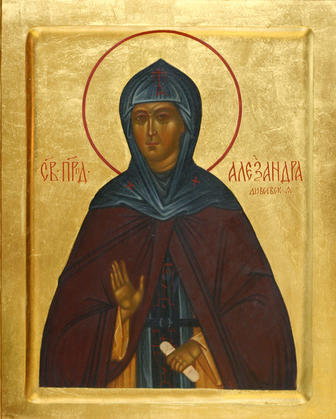Alexandra (Melgunova), foundress of Diveyevo Convent, venerable
Dates of commemoration
(Church calendar - Aug 28) Synaxis of all saints of Nizhny Novgorod (movable feast on the Sunday after August 26th)
Life
Agatha Semyonovna Melgunova while in the world was a rich landowner of the Yaroslavl, Vladimir and Ryazan provinces. Widowed at an early age, in about 1760 she came to the Kiev Florovsky women's monastery, where she was tonsured into monasticism under the name of Alexandra and began zealously to lead the ascetic life. However, she was not destined to remain there long: the Mother of God appeared to her in a vision and revealed to her her will, saying that she was destined to found a new monastery.
Under the guidance of the Mother of God, and after prolonged wanderings, St. Alexandra finally attained the place chosen by the Mother of God for the creation of her new monastery - "her fourth lot in the inhabited world". This was the village of Diveyevo in Nizhni-Novgorod province. At that time there flourished, not far away, the coenobitic men's monastery of Sarov. It had a strict rule, znamenny chant and many ascetics of holy life (it was founded in 1705). Its monastic tradition went back, apparently, to the holy hesychasts of the Kiev Caves.
Not far from here, under the guidance of the Sarov ascetics, Mother Alexandra began to live the ascetic life in a cell next to a church in honour of the Kazan icon of the Theotokos. She used her great wealth for the construction and renovation of churches, she provided for many orphans, widows and poor people, and lived by the work of her hands, struggling in the most difficult physical labour (she cleaned the cattle-shed and washed clothes). The Diveyevo peasants recalled her profound humility and secret good works for a long time.
Soon novices began to join her, and a small community was formed. Voluntary poverty, the receptions of wanderers, handiwork, unceasing practice of the Jesus prayer - that is what Mother Alexandra implanted in her Kazan community - "bone of the bone and flesh of the flesh of the Sarov desert". All this introduced the community from the beginning into the channel and tradition of Orthodox monasticism.
Already during her lifetime many knew and venerated Mother Alexandra as an ascetic who was very experienced in the spiritual life. "People flowed to her from all sides: not only simple people, but also highly placed people, merchants and even clergy, so as to listen to her instructions, receive her blessing and advice and be counted worthy of her welcome" (p. 31).
St. Alexandra reposed on June 13, 1789. Before her death she foretold the construction of a large monastery and the disorders that were to take place in it. A week or two before her death she was tonsured into the great angelic schema with the name of Alexandra.
St. Seraphim himself during her lifetime always spoke about her with profound respect, and after her death he witnessed to the fact that she was at the throne of God and taught the sister to ask for her prayers for everyone: "her clothing had many patches, her shawl was old, while her eyes never dried from her tears, and to this day I kiss the prints of her feet. She rests in her relics. Go to her grave every day, matushka, bow down and say: 'Our mistress and mother, forgive me and pray for me, as you were forgiven by the Lord, so may I be forgiven, and remember me at the throne of God" (p. 284). In the monastery there were written witnesses to the miracles and healings wrought by Mother Alexandra after her death. For example, in 1879, being near death, the retired lieutenant F.N. Sergeyev recovered from an incurable illness: being raised in mind to Sarov and there receiving the order from St. Seraphim to go for healing to Diveyevo to Mother Alexandra, he was healed through anointing with holy myrrh from the relics of Mother Alexandra. At that time he saw the relics themselves - "the skeleton entire, the bones like the purest amber, and from the skull there flowed three streams of holy myrrh, one in the middle of the forehead, and the two others along the sides from the eye-sockets" (p. 730). Once St. Alexandra appeared in sleep to a seriously ill woman and ordered her to turn for healing to St. Seraphim. St. Alexandra also continued to work healings and signs from her portrait, which began to venerated as wonderworking in the community (pp. 730-731).
Source:
http://www.roacusa.org/htdocs/diveevo.htm
Holy relic type
unless specified otherwise below, "holy relic" means a fragment of a bone of the saint
Holy relic
Location of the holy relic in the Cathedral:
Icon of venerable nuns of Diveyevo, north wall of the nave, east corner
Troparion
Тропарь преподобным Александре, Марфе и Елене Дивеевским, глас 4
Явилися есте земли Российския украшение, начальницы обители Дивеевския преподобныя матери наша Александро, Марфо и Елено, благословение Царицы Небесныя исполнившия и дерзновение ко господу стяжавшия, молите у престола Пресвятыя Троицы о спасении душ наших.
Kontakion
Кондак преподобным Александре, Марфе и Елене Дивеевским, глас 8
Дивеевския светильницы всесветлыя, преподобныя матери наша Александро, Марфо и Елено, в пощении, бдении, молитве и трудех добре подвизалися есте и по смерти нас освещаете чудес источеньми и исцеляете недугующих души; молите Христа Бога грехов оставление даровати любовию чтущим святую память вашу.






